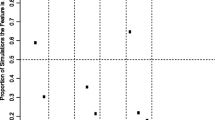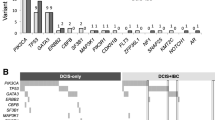Abstract
Background
Ductal carcinoma in situ (DCIS) is a preinvasive lesion of the breast with an inherent but nonobligatory tendency for progression to invasive breast cancer. Although the transition from in situ to invasive disease is critical to the development of breast cancer, molecular and biological changes responsible for this transition are not well characterized.
Methods
Chromosomal alterations at 26 regions were assayed in 66 DCIS lesions and 111 invasive ductal carcinomas. Levels and patterns of allelic imbalance (AI) were compared between grade 1 DCIS and well-differentiated breast carcinomas, and between grade 3 DCIS and poorly differentiated invasive breast carcinomas, using Fisher’s exact and Student’s t-tests.
Results
Levels of AI were significantly lower (P < 0.01) in grade 1 DCIS (11.9%) compared to well-differentiated carcinomas (19.2%), but were not significantly different between grade 3 DCIS and poorly differentiated tumors. No significant differences were detected at any of the 26 chromosomal regions between low-grade DCIS and invasive tumors; however, AI events at chromosomes 1p36, 11q23, and 16q11–q22 could discriminate high-grade in situ from invasive disease.
Conclusion
Lower levels of AI in low-grade in situ compared with invasive disease may reflect the protracted time to progression associated with low-grade DCIS. Increased levels of AI at chromosomes 1p36 and 11q23 in poorly differentiated carcinomas may harbor genes associated with invasiveness, while loss of chromosome 16q11–q22 may prevent the transition from in situ to invasive disease. Further characterization of these changes may provide molecular assays to identify DCIS lesions with invasive potential as well as targets for molecular therapeutics.

Similar content being viewed by others
References
Lagios MD, Margolin FR, Westdahl PR, et al. Mammographically detected duct carcinoma in situ. Frequency of local recurrence following tylectomy and prognostic effect of nuclear grade on local recurrence. Cancer 1989; 63:618–24
Fisher B, Costantino J, Redmond C, et al. Lumpectomy compared with lumpectomy and radiation therapy for the treatment of intraductal breast cancer. N Engl J Med 1993; 328:1581–6
Schwartz G. The role of excision and surveillance alone in subclinial DCIS of the breast. Oncology 1994; 8:21–6
Skinner KA, Silverstein MJ. The management of ductal carcinoma in situ of the breast. Endocr Rel Cancer 2001; 8:33–45
Done SJ, Eskandarian S, Bull S, et al. p53 missense mutations in microdissected high-grade ductal carcinoma in situ of the breast. J Natl Cancer Inst 2001; 93:700–4
Ho GH, Calvano JE, Bisogna M, et al. In microdissected ductal carcinoma in situ, HER-2/neu amplification, but not p53 mutation, is associated with high nuclear grade and comedo histology. Cancer 2000; 89:2153–60
Keohavong P, Gao W-M, Mady HH, et al. Analysis of p53 mutations in cells taken from paraffin-embedded tissue sections of ductal carcinoma in situ and atypical ductal hyperplasia of the breast. Cancer Lett 2004; 212:121–30
Buerger H, Mommers EC, Littmann R, et al. Ductal invasive G2 and G3 carcinomas of the breast are the end stages of at least two different lines of genetic evolution. J Pathol 2001; 194:165–70
Ellsworth RE, Hooke JA, Love B, et al. Correlation of levels and patterns of genomic instability with histological grading of invasive breast tumors. Breast Cancer Res Treat. 2008; 107:259–65
Roylance R, Gorman P, Harris W, et al. Comparative genomic hybridization of breast tumors stratified by histological grade reveals new insights into the biological progression of breast cancer. Cancer Res 1999; 59:1433–6
Roylance R, Gorman P, Hanby A, et al. Allelic imbalance analysis of chromosome 16q shows that grade I and grade III invasive ductal breast cancers follow different genetic pathways. J Pathol 2002; 196:32–6
The Consensus Conference Committee. Consensus conference on the classification of ductal carcinoma in situ. Hum Pathol 1997; 28:1221–5
American Joint Committee on Cancer. AJCC Cancer Staging Manual. New York: Springer, 2002
Bloom HJ, Richardson WW. Histological grading and prognosis in breast cancer. Br J Cancer 1957; 11:359–77
Elston CW, Ellis IO. Pathological prognostic factors in breast cancer. I. The value of histological grade in breast cancer: experience from a large study with long-term follow up. Histopathology 1991; 19:403–10
Ellsworth DL, Shriver CD, Ellsworth RE, et al. Laser capture microdissection of paraffin-embedded tissues. Biotechniques 2003; 34:42–6
Ellsworth RE, Ellsworth DL, Lubert SM, et al. High-throughput loss of heterozygosity mapping in 26 commonly deleted regions in breast cancer. Cancer Epidemiol Biomarkers Prev. 2003; 12:915–9
Medintz IL, Lee C-CR, Wong WW, et al. Loss of heterozygosity assay for molecular detection of cancer using energy-transfer primers and capillary array electrophoresis. Genome Res 2000; 10:1211–8
Ellsworth RE, Ellsworth DL, Neatrour DM, et al. Allelic imbalance in primary breast carcinomas and metastatic tumors of the axillary lymph nodes. Mol Cancer Res 2005; 3:71–7
Lichy JH, Dalbegue F, Zavar M, et al. Genetic heterogeneity in ductal carcinoma of the breast. Lab Invest 2000; 80:291–301
Miller BJ, Wang D, Krahe R, et al. Pooled analysis of loss of heterozygosity in breast cancer: a genome scan provides comparative evidence for multiple tumor suppressors and identifies novel candidate regions. Am J Hum Genet 2003; 73:748–67
Ernster V, Barclay J, Kerlikowske Grady D, et al. Incidence and treatment for ductal carcinoma in situ of the breast. JAMA 1996; 275:913–8
Ellsworth RE, Ellsworth DL, Deyarmin B, et al. Timing of critical genetic changes in human breast disease. Ann Surg Oncol 2005; 12:1054–60
Kim HJ, Park C, Park BW, et al. Expression of MT-1 MMP, MMP2, MMP9 and TIMP2 mRNAs in ductal carcinoma in situ and invasive ductal carcinoma of the breast. Yonsei Med J 2006; 47:333–42
Brummer O, Athar S, Riethdorf L, et al. Matrix-metalloproteinases 1,2, and 3 and their tissue inhibitors 1 and 2 in benign and malignant breast lesions: an in situ hybridization study. Virchows Arch 1999; 435:566–73
Hainsworth PJ, Raphael KL, Stillwell RG, et al. Rearrangement of chromosome 1p in breast cancer correlates with poor prognostic features. Br J Cancer 1992; 66:131–5
Borg A, Zhang QX, Olsson H, et al. Chromosome 1 alterations in breast cancer: allelic loss on 1p and 1q is related to lymphogenic metastases and poor prognosis. Genes Chromosomes Cancer 1992; 5:311–20
Ragnarsson G, Eiriksdottir G, Johannsdottir JT, et al. Loss of heterozygosity at chromosome 1p in different solid human tumours: association with survival. Br J Cancer 1999; 79:1468–74
Kim TY, Lee HJ, Hwang KS, et al. Methylation of RUNX3 in various types of human cancers and premalignant stages of gastric carcinoma. Lab Invest 2004; 84:479–84
Lau WC, Raja E, Salto-Tellez M, et al. RUNX3 is frequently inactivated by dual mechanisms of protein mislocalization and promoter hypermethylation in breast cancer. Cancer Res. 2006; 66:6512–20
Chen W, Salto-Tellez M, Palanisamy N, et al. Targets of genome copy number reduction in primary breast cancers identified by integrative genomics. Genes Chromosomes Cancer 2007; 46:288–301
Koreth J, Bakkenist CJ, McGee JO. Chromosomes, 11Q and cancer: a review. J Pathol 1999; 187:28–38
Koreth J, Bakkenist CJ, Larin Z, et al. 11q23.1 and 11q25-qter YACs suppress tumour growth in vivo. Oncogene 1999; 18:1157–64
Buerger H, Otterbach F, Simon R, et al. Comparative genomic hybridization of ductal carcinoma in situ of the breast-evidence of multiple genetic pathways. J Pathol 1999; 187:396–402
Ellsworth RE, Ellsworth DL, Love B, et al. Correlation of levels and patterns of genomic instability with histological grading of DCIS. Ann Surg Oncol 2007; 14:3070–7
Roylance R, Gorman P, Papior T, et al. A comprehensive study of chromsome 16q in invasive ductal and lobular breast carcinoma using array CGH. Oncogene 2006; 25:6544–53
Vos CB, ter Haar NT, Rosenberg C, et al. Genetic alteration on chromosome 16 and 17 are important features of ductal carcinoma in situ of the breast and are associated with histologic type. Br J Cancer 1999; 81:1410–8
Berx G, Cleton-Jansen AM, Nollet F, et al. E-cadherin is a tumour/invasion suppressor gene mutated in human lobular breast cancers. EMBO J 1995; 14:6107–15
van Wezel T, Lombaerts M, van Roon EH, et al. Expression analysis of candidate breast tumor suppressor genes on chromosome 16q. Breast Cancer Res 2005; 7:R998–1004
Henson DE, Ries L, Freedman LS, et al. Relationship among outcome, stage of disease, and histologic grade for 22,616 cases of breast cancer. Cancer 1991; 68:2142–9
Polette M, Clavel C, Cockett M, et al. Detection and localization of mRNAs encoding matrix metalloproteinases and their tissue inhibitor in human breast pathology. Invasion Metastasis 1993; 13:31–7
Boecker W, Buerger H, Schmitz K, et al. Ductal epithelial proliferations of the breast: a biological continuum? Comparative genomic hybridization and high-molecular-weight cytokeratin expression patterns. J Pathol 2001; 195:415–21
Rakha EA, Green AR, Powe DG, et al. Chromosome 16 tumor-suppressor genes in breast cancer. Genes Chromosomes Cancer 2006; 45:527–35
Sanders ME, Schuyler PA, Dupont WD, et al. The natural history of low-grade ductal carcinoma in situ of the breast in women treated by biopsy only revealed over 30 years of long-term follow-up. Cancer 2005; 103:2481–4
Acknowledgements
This research was supported by a grant from Susan G. Komen for the Cure (BCTR0600366) to R.E.E. and the United States Department of Defense (Military Molecular Medicine Initiative MDA W81XWH-05-2-0075). The opinion and assertions contained herein are the private views of the authors and are not to be construed as official or as representing the views of the Department of the Army or the Department of Defense.
Author information
Authors and Affiliations
Corresponding author
Additional information
Address reprints requests to: Ms. Kerri Cronin, Clinical Breast Care Project, Walter Reed Army Medical Center, 6900 Georgia Avenue, NW, Washington, DC 20307, USA; E-mail: kerri.cronin@amedd.army.mil.
Rights and permissions
About this article
Cite this article
Ellsworth, R.E., Vertrees, A., Love, B. et al. Chromosomal Alterations Associated with the Transition from In Situ to Invasive Breast Cancer. Ann Surg Oncol 15, 2519–2525 (2008). https://doi.org/10.1245/s10434-008-0051-7
Received:
Revised:
Accepted:
Published:
Issue Date:
DOI: https://doi.org/10.1245/s10434-008-0051-7




